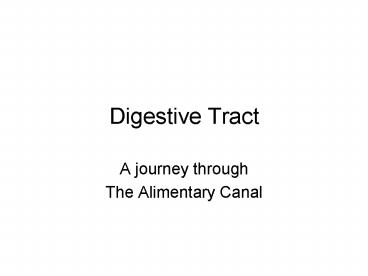Digestive Tract - PowerPoint PPT Presentation
1 / 27
Title:
Digestive Tract
Description:
Digestive Tract A journey through The Alimentary Canal Digestive Tract a) Oral Cavity b) Tubular Tract c) Major Digestive Glands Digestive Tract Functions: a ... – PowerPoint PPT presentation
Number of Views:74
Avg rating:3.0/5.0
Title: Digestive Tract
1
Digestive Tract
- A journey through
- The Alimentary Canal
2
Digestive Tract
- a) Oral Cavity
- b) Tubular Tract
- c) Major Digestive Glands
3
Digestive Tract
- Functions
- a) physical treatment mastication
- b) secretion water, bicarbonate, enzymes
- c) chemical treatment - digestion
- d) transportation - swallowing, peristalsis.
- e) absorption assimilation
- f) elimination - defecation
4
Oral Cavity
- Lips - skeletal muscle embedded between
- a) inner fibroelastic areolar (lamina propria)
covered with non-cornified stratified squamous
epithelial mucosa, continuous with cheek (same
except addition of sub-mucosa in cheek). - b) outer fibroconnective CT (dermis) covered
with cornified strat. squamous epithelium
(epidermis). - No hair or glands, moistened only by licking
5
Oral Cavity
- Tongue - skeletal muscle core covered with
mucosa. - Upper surface rough, non-cornified stratified
squamous epithelium with papillae. - Upper surface divided into two regions
- 1) lingual tongue - free, distal half covered
with - tall hair-like papillae in rows on anterior
center of the tongue (filiform) - mushroom shaped papillae on tip of tongue
(fungiform) - leaf-shaped papillae on side of tongue (foliate)
- poorly developed in humans.
6
Tongue
- 2) lymphoid tongue - basally attached zone
separated from the lingual by a V-shaped groove
(sulcus pit Sulcus terminalis). - Large papillae line the back margin of the pit
each papilla is surrounded by a moat (ditch) -
Circumvallate papillae 7-12 in number.
7
(No Transcript)
8
Taste Bud
9
Salivary Glands
- Secrete saliva (water, salts, mucin, lysozyme,
and amylase) into the oral cavity. - Function in lubrication, starch digestion and
anti-microbial action. - Three glands
- Parotid
- Submandibular
- Sublingual
10
Salivary Glands
- Parotid Gland - largest salivary gland
- Paired, anterior and below the ear
- DICT capsule with many septa.
- Parenchyma of simple cuboidal serous cells
- Myoepithelium around acini.
- Ducts - 3 levels
- 1) intercalated - small, most abundant simple
cuboidal epithelium. Intralobular. - 2) striated - larger, fewer simple columnar
epithelium with basal striations. Intralobular. - 3) excretory - largest empty into the oral
cavity columnar -gt pseudostratified columnar -gt
stratified columnar epithelium. Interlobular.
11
(No Transcript)
12
Parotid Gland
13
Salivary Glands
- Submandibular (Submaxillary) Gland -
- Paired below the ramus of the mandible
- Parenchyma mostly of serous with some mucous
cuboidal epithelium - Striated ducts more prominent.
- Sublingual Gland
- Group of small glands on the floor of the oral
cavity beneath the tongue. - Each glandular body has its own ductule system.
- Parenchyma mixed with mostly mucous cuboidal.
- Intercalated ducts reduced in length and number.
14
Teeth
- 32 in adult derived from ectoderm and mesoderm.
- Two major parts
- a) Crown - exposed above gum (gingiva).
- Enamel outer surface dentin middle layer
dental pulp cavity interior. - b) Root - embedded in gum (gingiva). Cementum
outer surface dentin middle layer dental pulp
cavity interior.
15
(No Transcript)
16
Teeth
- Tooth is firmly attached to jawbone by
Periodontal Ligament of DICT - a) Dentin - harder than compact bone
- - mostly inorganic salt (72), Collagen, GAGs
- - permeated by many canals Dentinal Tubules
- - tubules occupied by odontoblast processes
(Tome's Fibers) of odontoblast cells. - Odontoblasts from neural crest.
17
Teeth
- Enamel hardest substance in the body.
- 96 inorganic salts secreted in alternating
layers of enamel rods (prisms) of inorganic
salts, and interrod matrix of inorganic salts and
amelogenins. - Enamel secreted by ameloblasts
- Ectodermal in origin.
- Enamel grows by layers Lines of Retzius.
18
Dentin Tubules
Odontoblast Processes
19
Teeth
- c) Cementum - covers dentin of the root similar
to bone. Upper 1/3 is cell-less lower 2/3 may
have osteons (w/o Haversian System and blood
vessels) and cementoblasts-cementocytes in
lacunae - Formed by cells from the periodontal membrane.
- Periodontal Membrane - modified periosteum -
occupies the space between the root and jawbone
contains white fibers only. Fibers embed in
cementum as Sharpy's Fibers.
20
Teeth
- Dental Pulp - cellular matrix with fibers like
mucoid CT - Odontoblasts line the inner dentin surface. A
single arteriole, venule and nerve are present.
21
Pharynx
- Transition between oral cavity, tubular digestive
tract, and respiratory tract. - Stratified non-keratinized squamous epith.
- Ciliated pseudostratified columnar (with goblet
cells) in area close to nasal cavity - Contains tonsils
- Numerous small mucous salivary glands
- Constrictor and longitudinal (swallowing) muscles
22
Tubular Digestive Tract
- Layers
- 1) Mucosa -
- a) epithelium
- b) lamina propria
- c) muscularis mucosa
- 2) Submucosa
- 3) Muscularis Externa -
- a) inner circular layer
- b) outer longitudinal layer
- 4) Serosa
23
(No Transcript)
24
Four Layers
- Mucosa
- a) epithelium - mucous membrane irregular
surface forms many glands, various tissue
types. - b) lamina propria - areolar CT thick layer,
houses glands forms villi contains many
lymphoid collections. - c) muscularis mucosa - 2 thin smooth muscle
layers inner circular and outer longitudinal.
25
Four Layers
- Submucosa - areolar to fibroconnective CT deep
and thick has many large blood vessels and
autonomic ganglia Submucosal Plexus (Meissner). - Muscularis Externa - thick smooth muscle layers
- Inner circular and outer longitudinal third
diagonal layer added in the stomach. - Terminal Ganglia present between the layers
Myenteric Plexus (Auerbach).
26
Four Layers
- Serosa - dense areolar CT
- if in body cavity and covered with simple
squamous epithelium mesothelium (serous
membrane).
27
(No Transcript)































